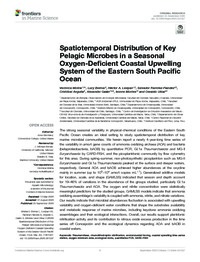Mostrar el registro sencillo de la publicación
Spatiotemporal distribution of key pelagic microbes in a seasonal oxygen-deficient coastal upwelling system of the Eastern South Pacific Ocean
| dc.contributor.author | Molina, Verónica | |
| dc.contributor.author | Belmar, Lucy | |
| dc.contributor.author | Levipan, Héctor A. | |
| dc.contributor.author | Ramírez-Flandes, Salvador | |
| dc.contributor.author | Anguita, Cristóbal | |
| dc.contributor.author | Galán, Alexander | |
| dc.contributor.author | Montes, Ivonne | |
| dc.contributor.author | Ulloa, Osvaldo | |
| dc.date.accessioned | 2021-11-18T14:48:57Z | |
| dc.date.available | 2021-11-18T14:48:57Z | |
| dc.date.issued | 2020 | |
| dc.identifier.uri | http://repositorio.ucm.cl/handle/ucm/3484 | |
| dc.description.abstract | The strong seasonal variability in physical-chemical conditions of the Eastern South Pacific Ocean creates an ideal setting to study spatiotemporal distribution of key marine microbial communities. We herein report a nearly 4-year-long time series of the variability in amoA gene counts of ammonia oxidizing archaea (AOA) and bacteria (betaproteobacteria, bAOB) by quantitative PCR, GI.1a Thaumarchaeota and MG-II Euryarchaeota by CARD-FISH, and the picoplanktonic community by flow cytometry for this area. During spring-summer, non-photosynthetic picoplankton such as MG-II Euryarchaeota and GI.1a Thaumarchaeota peaked at the surface and deeper waters, respectively. General AOA and bAOB achieved higher abundances at the oxycline mainly in summer (up to 105–104 amoA copies mL–1). Generalized additive models for location, scale, and shape (GAMLSS) indicated that season and depth account for 19–46% of variations in the abundance of the groups studied, particularly GI.1a Thaumarchaeota and AOA. The oxygen and nitrite concentration were statistically meaningful predictors for the studied groups. GAMLSS models indicate that ammonia oxidizing assemblage’s variability is coupled with ammonia, nitrite, and nitrate variations. Our results indicate that microbial abundances fluctuation is associated with upwelling variability and oxygen-deficient water conditions that shape the substrates availability and metabolic response of marine microbes, including keystone ammonia oxidizing assemblages and their ecological interactions. Overall, our results support planktonic nitrification activity and its contribution to nitrous oxide excess production in the time series off Concepción and the ecological dynamics regarding AOA and bAOB in coastal waters. | es_CL |
| dc.language.iso | en | es_CL |
| dc.rights | Atribución-NoComercial-SinDerivadas 3.0 Chile | * |
| dc.rights.uri | http://creativecommons.org/licenses/by-nc-nd/3.0/cl/ | * |
| dc.source | Frontiers in Marine Science, 7, 561597 | es_CL |
| dc.subject | Thaumarchaea | es_CL |
| dc.subject | Chemolithotrophic nitrification | es_CL |
| dc.subject | Environmental forcing | es_CL |
| dc.subject | Coastal upwelling time-series station | es_CL |
| dc.subject | Oxygen minimum zone | es_CL |
| dc.subject | Ecological niche | es_CL |
| dc.subject | Quantitative PCR | es_CL |
| dc.subject | CARD-FISH | es_CL |
| dc.title | Spatiotemporal distribution of key pelagic microbes in a seasonal oxygen-deficient coastal upwelling system of the Eastern South Pacific Ocean | es_CL |
| dc.type | Article | es_CL |
| dc.ucm.facultad | Facultad de Ciencias de la Ingeniería | es_CL |
| dc.ucm.indexacion | Scopus | es_CL |
| dc.ucm.indexacion | Isi | es_CL |
| dc.ucm.doi | doi.org/10.3389/fmars.2020.561597 | es_CL |



